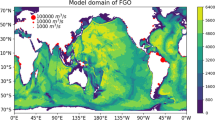Abstract
A global picture of ocean current variability may be obtained by analyzing surface drift currents in terms of their mean and eddy kinetic energies. High values for both quantities are found in the western boundary currents and in the equatorial current system; low values are found in the interior of major gyres. However, nowhere are eddy energies less than 200 cm2 s−2, indicating that, even in the least energetic parts of the oceans, surface speeds of ~20 cm s−1 prevail. Recent experimental studies also support the widespread occurrence of mesoscale mid-oceanic eddies. Another type of eddy is abundant in the vicinity of boundary currents: examples include Gulf Stream Rings, the ‘Great Whirl’ of the Somali Current, and disturbances of the predominantly zonal equatorial flow manifested by large-scale meandering about the equator. Recent numerical models using low-viscosity and high-resolution computational grids also reveal the ubiquitous existence of mesoscale structures. The importance of eddies is that they seem to be energetic enough and sufficiently widespread so as to play some part — not yet understood — in the circulation of the world ocean. Speculative analogies to the atmosphere suggest that the mesoscale ocean eddies are ‘the storms and weather systems of the sea’. We need global statistics on their distribution, their occurrence in various oceanic regions, their dimensions, and their lifetimes. The prospect of even a single global oceanic ‘weather map’, comparable to those obtained daily for the atmosphere, is hopeless in terms ofin situ oceanographic observations. Remote sensing may provide a partial solution.
In the past, sea-surface temperature observations by satellites have revealed cold and warm eddies shed by western boundary currents. Satellite observations, moreover, have shown the thermal effects of continental shelf waves and areas with pronounced upwelling. These phenomena are characterized by strong temperature gradients and relatively large differences in surface elevation. Mid-ocean eddies are far more subtle and difficult to observe since they possess smaller differences of temperature and sea-surface topography. Three representative examples, including recent experimental results in western boundary currents, the equatorial region, and a typical mid-ocean region, are discussed in detail. Typical signals of temperature and sea-level topography, as well as typical temporal and spatial scales of the observed phenomena, are given.
Similar content being viewed by others
References
Cox, M. D.: 1976, ‘Equatorially Trapped Waves and the Generation of the Somali Current’,Deep-Sea Res. 23, 1139–1152.
Düing, W. and Szekielda, K.-H.: 1971, ‘Monsoonal Response in the Western Indian Ocean’,J. Geophys. Res. 76, 4181–4187.
Düing, W.: 1975, ‘Synoptic Studies of Transients in the Florida Current’,J. Mar. Res. 33, 53–73.
Düing, W.: 1976, ‘Low-Frequency Variability of the Florida Current’, Abstract of poster presentation at the Joint Oceanographic Assembly, Edinburgh, 13–24 Sept. 1976’, IAPSO Poster Session IV.
Han, Y. J.: 1975, ‘Numerical Simulation of Mesoscale Ocean Eddies’, Ph.D. dissertation, Dept. of Meteorology, University of California, Los Angeles.
Hansen, D. V.: 1970, ‘Gulf Stream Meanders Between Cape Hatteras and the Grand Banks’,Deep-Sea Res. 17, 495–511.
Hurlburt, H. E. and Thompson, J. D.: 1976, ‘A Numerical Model of the Somali Current’,J. Phys. Oceanogr. 6, 646–664.
Legeckis, R.: 1975, ‘Application of Synchronous Meteorological Satellite Data to the Study of Time-Dependent Sea Surface Temperature Changes Along the Boundary of the Gulf Stream’,Geophys. Res. Let. 2, 435–438.
Maul, G. A.: 1976, ‘Recent Progress in the Remote Sensing of Ocean Surface Currents’,J. Mar. Tech. Soc. 11, 5–13.
Orlanski, I. and Cox, M. D.: 1973, ‘Baroclinic Instability in Ocean Currents’,Geophys. Fluid Dyn. 4, 297–332.
Schott, F. and Düing, W.: 1976, ‘Continental Shelf Waves in the Florida Straits’,J. Phys. Oceanogr. 6, 451–460.
Swallow, J. C.: 1976, ‘Variable Currents in Mid-Ocean’,Oceanus 19, 18–25.
Teague, W. J.: 1974, ‘Refraction of Surface Gravity Waves in an Eddy’, M.S. Thesis, University of Miami/Rosenstiel School of Marine and Atmospheric Science, 94 pp.
Voorhis, A. and Schroeder, E.: 1976, ‘Sea Surface Temperature During MODE-I’,Oceanus 19, 82–86.
Wyrtki, K.: ‘Fluctuations of the dynamic topography in the Pacific Ocean’,J. Phys. Oceanogr. 5 (3), 450–459, 1975.
Wyrtki, K., Magaard, L., and Hager, J.: ‘Eddy Energy in the Oceans’,J. Geophys. Res. 81 (51), 2641–2646, 1976
Author information
Authors and Affiliations
Rights and permissions
About this article
Cite this article
Düing, W. Spatial and temporal variability of major ocean currents and mesoscale eddies. Boundary-Layer Meteorol 13, 7–22 (1978). https://doi.org/10.1007/BF00913859
Received:
Issue Date:
DOI: https://doi.org/10.1007/BF00913859




